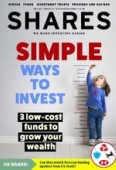Archived article
Please note that tax, investment, pension and ISA rules can change and the information and any views contained in this article may now be inaccurate.
How to turn £10,000 into £100,000

Wouldn’t it be nice to turn £10,000 into £100,000 by investing in the stock market, and not having to wait a lifetime for it happen? It is possible but not necessarily easy.
The level of difficulty really depends on your timeframe and risk appetite as we shall explain in this article.
We have approached the task by looking at what different assets have historically returned to investors over very long-time frames.
The annual Barclays Equity-Gilt study shows that over the last 121 years UK equities as represented by the FTSE All-Share index have delivered a compound annual growth rate of 8.9% a year.
It’s paramount to stress this return includes reinvesting all dividend income. Without reinvesting income, the compound average growth rate falls to 4.2% a year.
Presenting the data in percentages might not paint as useful a picture as doing so in actual money.

£100 invested in 1899 would theoretically be worth £2.9 million today if all dividend income were reinvested compared with a mere £15,179 if not. This dramatically shows the effect of compounding over very long periods.
For comparison purposes investing in the government bond markets would have returned £48,885 and a bank deposit account would theoretically be worth £20,933.
It’s worth pondering over these facts, because it is conventional wisdom that shares outperform bonds in the long run but much less commonly known that this performance is entirely dependent on reinvesting dividend income.
INVESTING IN THE STOCK MARKET
Assuming the FTSE All-Share delivered a similar return in the future (we should explain here that 8.9% a year in aggregate is composed of a wide range of different annual returns), it would take around nine years to simply double your capital by investing in a fund that tracked the index.
This excludes fees and tracking error, or the difference between the underlying index return and the fund return.
However, to get to 10 times our starting capital (i.e. turn £10,000 into £100,000) we need to double the capital another four times. At an annual growth rate of 8.9% it would take another 18 years of continuous investing and reinvesting dividends, or around 27 years in total, to achieve the goal.
Because the FTSE All-Share is composed of around 600 companies it provides a very diversified and low risk exposure to many names on the UK stock market (it’s virtually impossible for the index to become worthless).
That’s not to say it is riskless, remember that shares are still risky even held in a diversified portfolio. The Barclays study shows there have been decades where equities have provided negative returns, but they are relatively rare.
One way to track the FTSE All-Share index is via a fund such as the iShares UK Equity Index Fund (B7C44X9) which charges 0.05% a year.
MOVING UP THE RISK LADDER
Individual shares can deliver a 10-fold return in relatively short time frames but finding them ahead of such an explosive move is very challenging. Also, bear in mind that putting all your £10,000 capital in a single company risks losing it all.
And remember that for an individual share to go up 10-fold the underlying business needs to grow by a similar magnitude or the valuation placed on the business needs to increase dramatically.
SHARES THAT HAVE GONE UP 10-FOLD IN UNDER FIVE YEARS
Digital media group Future (FUTR) has delivered a compound annual growth rate of 100% a year in just over three years, providing investors with a 10-bagger in that time frame.

This is down to a mixture of earnings growth and an increased valuation multiple put on the business by investors.
Metals exploration group Greatland Gold (GGP:AIM) has seen its shares rise 10-fold over the last two-and-a-half years, and better still has a five-year compound annual growth rate of 157% a year, equivalent to turning £10,000 into £1.1 million in five years.

Faster still, investors in electric car company Tesla have seen their shares rise 10-fold in under two years. Tesla hasn’t increased its profits by 10-times in the last two years, but investors have bet that the company will become more profitable.

This underscores the difficulty of finding the path to big quick returns – it relies on human emotions. As Isaac Newton once said: ‘I can calculate the motion of heavenly bodies but not the madness of people.’
STOCK SUGGESTIONS
That said, if you don’t try you won’t achieve anything, so with that thought in mind we highlight two stocks that might provide super-sized returns in the years to come.
We are looking for the investment to work out (grow 10-fold) over the next three to eight years which implies that earnings are growing between 33% a year and 100% a year, but we are also looking for the potential for multiple expansion.
In plain English, that means investors are prepared to pay a higher multiple of earnings to own the shares. For example, a stock might have traded on 20 times earnings, but it’s done something to convince the market it should now trade on
30 times earnings – that’s a multiple expansion.
The most powerful stock moves are often a combination of profit growth (fundamentals) and multiple expansion (investors paying more for the profits).
Just remember there are no guarantees with investing and that you can lose money as well as make it.
CVS (CVSG:AIM) £24
Market value: £1.7 billion
Integrated veterinary practices group CVS (CVSG:AIM) has grown its revenues at a compound annual growth rate of 15% and earnings at 20% over the past three years.

While this was partly the result of increased demand for pet ownership during lockdown, we believe the industry has secular growth drivers.
The company has a good growth runway which it can deliver through both organic and acquisitive means while it is achieving its aim of becoming the employer of choice.
One aspect of the business which we find interesting and is perhaps underappreciated is the increasing number of services that have been rolled out in recent years. These range from crematoria, laboratories, referrals to insurance and e-commerce.
Not only do these additional services bring incremental revenues but they address the whole life cycle of owning companion animals and potentially create a network effect where CVS attracts third parties to its nexus.
There is potential for margins to increase as the company scales its operations and as the network effect takes hold, which should attract a higher multiple.
Darktrace (DARK) 964p
Market value: £6.3 billion
Cyber security company Darktrace (DARK) is one of the world’s fastest growing companies with a leadership position in Enterprise Immune System technology, which is based on pioneering mathematics developed at Cambridge University.

The underlying cyber security market is forecast to grow at around a compound annual growth rate of 14.6% a year over the next five years and could be worth around $400 billion according to Fact and Factors research, while Darktrace could exploit its technological edge to carve out a leading position.
Analysts at Needham Research believe Darktrace has the most innovative application of artificial intelligence and security automation in the market.
While the company’s shares have been hugely successful since coming to the market in April 2021, there appears to be good momentum in the business with management increasing earnings guidance given at the time of the floatation.
Even if Darktrace only matches the current consensus forecast for 2023 revenues of around $493 million, arguably that is barely scratching the surface in terms of the estimated market potential.
Investors will naturally want to see progression on turning revenues into profits from the losses projected but the bigger picture is about grabbing a good slice of the ever-expanding cyber security market and Darktrace seems to be delivering so far.
Important information:
These articles are provided by Shares magazine which is published by AJ Bell Media, a part of AJ Bell. Shares is not written by AJ Bell.
Shares is provided for your general information and use and is not a personal recommendation to invest. It is not intended to be relied upon by you in making or not making any investment decisions. The investments referred to in these articles will not be suitable for all investors. If in doubt please seek appropriate independent financial advice.
Investors acting on the information in these articles do so at their own risk and AJ Bell Media and its staff do not accept liability for losses suffered by investors as a result of their investment decisions.
Issue contents
Editor's View
Feature
Great Ideas
- XP Power lining up M&A drive
- Time to buy into SAP’s cloud shift before the market catches up
- Small cap consumer goods firm shrugs off supply chain issues
- Disney still a great long-term investment despite film delays
- Buy wholesaler Kitwave which is firmly in the driving seat
- QiniteQ sell-off represents a good buying opportunity
News
- What to expect in the latest updates from UK banks
- Life sciences property investor to break new ground
- Bitcoin ETF optimism feeds latest cryptocurrency rally
- Uranium’s glowing performance amid energy crisis
- ProCook and Stelrad plot main market flotations
- China could export inflation to the rest of the world

 magazine
magazine








